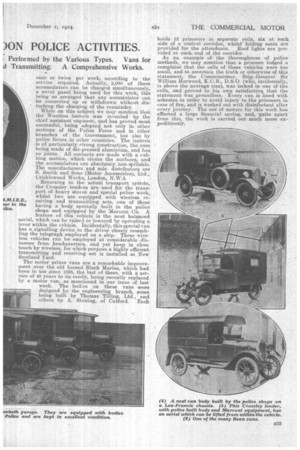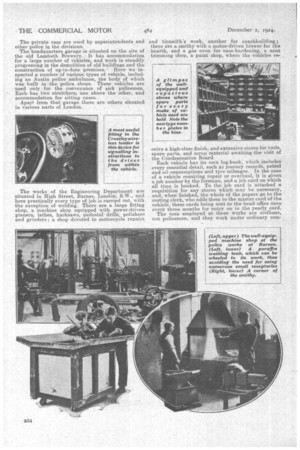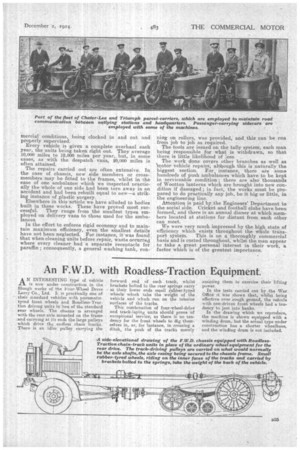THE MOTOR'S PART IN )0N POLICE 'ACTIVITIES.
Page 16

Page 17

Page 18

Page 19

If you've noticed an error in this article please click here to report it so we can fix it.
Details of the Fleet of 200 Vehicles and of 1 Prisoners, Accumulators and Wireless Rec
Performed by the Various Types. Vans for d Transmitting. A Comprehensive Works,
rPHE British Police System has for long been a
pattern copied almost with reverence by other countries. We have a habit here of alluding somewhat disparagingly to the work of our public institutions, but tke well-behaved citizen has an inborn pride in the -,high efficiency wad incorruptibility of our Police as a whole, whilst those of our citizens who cannot be referred to in the same terms prove by their fear for our guardians of the peace 'that they have a wholesome respect for their capabilities.
Of this fine body the Metropolitan Police foams the core, and it is surprising how little the average Londoner knows about the work of this section, which includes some 20,000 of all ranks. The Metropolitan Police area covers some 700 square miles of London, and every polite station within this area must be in constant communication with the headquarters at Scotland Yard, not only by post and telephone, but by road services.
Many people have seen in the daily Press, from time to time, observations regarding the Flying Squad, but few realize the extensive part which mechanical road transport plays in maintaining all-round efficiency in the Police Force. In this article we deal only with the Metropolitan Police, but for this force alone the fleet of motor vehicles totals 200 of all types, of which nuMber between 35 and 40 are private cars, . the reinainder including 17 prison vans on 2-1--ton Tilling-Stevens geardriven chassis, 24 despatch and accumulatorcarrying vans, chiefly of Bean make, a number of Crossley tenders of the well-known W.D. type, two Austin ambulances, one of the new 20-25-cwt. Beans, and a motorcycle section comprising machines of Chater-Lea and Triumph make, all equipped with sidecars, some of the commercial-box pattern and others of the ordinary passenger-carrying type. This big fleet forms the transport side of the engineering section, the engineer being Afajor T. H. Vitty, T.D., A.M.I.E.E., A.M.I.Mech.E., whose chief assistant is Mr. G. A. H. -Wootton, with Mr. J. C. Abbott as motorcar and motor boat assistant.
The -work of the Engineers' Department Major T. actually comprises all forms of engineering, A.M.I. Me
including the motor boats used by the river Me police, wireless, etc. The various district stations are, as we have already pointed out, interconnected by a comprehensive road transport system, motorcycle and sidecar combinations being used in the outer areas and the motor vans for the inner districts.
• These vehicles average about 100 miles per day. They collect lost property which has been handed in to the stations, despatches and, in the case of certain of the Bean vans, accumulators For the Wootton elec tric lanterns, of which several thousand are in constant use. There are twice as many accumulators as there are lanterns, so that when a stock is taken away for charging, full accumulators can be left at the station.
All the charging is done at headquarters, once or twice per week, according to the service required. Actually, 3,000 of these accumulators can be charged simultaneously, a novel panel being used for this work, this being so arranged that any accumulator can be connected up or withdrawn without disturbing the charging of the remainder. While an this subject we may mention that the Wootton lantern was invented by the chief assistant engineer, and has proved most successful, being adopted not only in other sections of the Police Force and in other branches of the Government, but also by police forces in other conntries. The lantern is of particularly Ftrong construction, the case being made of die-pressed aluminium, and has no joints. All contacts are made with a rubbing motibn, which cies:us the surfaces, and the accumulators are absolutely non-spillable. The manufacturers and sole distributors are S. Smith and Sons (Motor Accessories), Ltd., Cricklewood Works, London, N.W.2. Returning to the actual transport systetn, the Crossley tenders are used for the transport of heavy stores and special police work, whilst two are equipped with wireless receiving and transmitting sets, one of these having a body specially built in the police shops and equipped by the Marconi Co. A feature of this vehicle is the neat balanced aerial, which can be raised or lowered by operating a lever within the vehicle. Incidentally, this special van has a signalling .device to the driver closely resembling the telegraph employed on a ship. These wireless vehicles can be employed at considerable distances from headquarters, and yet keep in close touch by Wireless, for which purpose a highly efficient transmitting and receiving set is installed at New Scotland Yard.
The motor prison vans are a remarkable improvement over the old horsed Black Marias, which had been in use since 1838, the last of these, with a service of 40 years to its credit, being recently replaced by a motor van as mentioned in our issue of last week. The bodies on these vans were designed by the engineering branch, some being built by Thomas Tilling, Ltd., and others by A. Stening, of Catford. Each
holds 12 prisoners in separate cells, six at each side of a central corridor, whilst folding seats are provided for the attendants. Roof lights are provided at each end of the corridor.
As an example of the thoroughness of police methods, we may mention that a prisoner lodged a complaint that the cells of these vehicles were too small, and to ascertain the truth or otherwise of this statement, the Commissioner, Brig.-General Sir William Horwood, K.C.B., D.S.O. (who, incidentally, is above the average size), Was locked in one of the cells, and proved to his own satisfaction that the statement was groundless. Every van iè lined with asbestos in order to avoid injury to the prisoners in case of fire, and is washed out with disinfectant after every journey. The use cif motors for this work has effected a large financial saving, and, quite apart from this, the work is carried out much more ex. peditiously.
The private cars are used by superintendents and other police in the divisions: The headquarters garage is situated on the site of the old Lambeth Brewery. It has accommodation for a large number of vehicles, and work is steadily progressing in the demolition of old buildings and the construction of up-to-date premises. Here we inspecter] a number of various types of vehicle, including an Austin police ambulance, the body of which was built in the police shops. These vehicles are used only for the conveyance of sick policemen. Each has two stretchers; one above the other, and accommodation for sitting cases.
Aparlfrom that garage there are others situated in various parts of London..
The works of the Engineering Department are situated in High Street, Barnes, London, S.W., and here practically every type of job is carried out, with the exception of welding. There are a large fitting shop, a machine shop equipped with power-driven planers, lathes, hacksaws, pedestal drills, polishers and grinders ; a shop devoted to motorcycle repairs and tinsmith's work, another for coachbuilding ; there are a smithy with a motor-driven blower lot the hearth, and a gas oven for case-hardening,. a neat trimming shop, a paint shop, where the vehicles re eeive a high-class finish, and extensive stores for tools, spare parts, and scrap material awaiting the visit of the Condemnation Board.
Each vehicle has its own log-book, which includes every essential detail, such as journey records, petrol and oil consumptions and tyre mileages. In the case of a vehicle requiring repair or overhaul, it is given a job number by the foreman, and a job card on which all time is booked. To the job card is attached a' requisition for any stores which may be necessary, and, when finished, the whole of the papers go to the costing clerk, who adds them to the master card of the vehicle, these cards being sent to the -head office once every three months for entry on to the yearly card. The men employed at these works are civilians, not policemen, and they work under ordinary corn naerciar conditions, being clocked in and out and properly supervised.
Every vehicle is given a complete overhaul each year, the units being taken right out. They average 10,000 miles to 12,000 miles per year, but, in some cases, as with the despatch vans, 20,000 miles is often attained.
'The repairs carried out are often extensive. In the case of chassis, new side members or crossmembers may be fitted to the frames, whilst in the case of one ambulance which we inspected practically the whole of one side had been torn away in an 'accident and had been rebuilt equal to new—a striking instance of plastic surgery. Elsewhere in this article we have alluded to bodies built in these works. These have proved most successful. They range from the smallest types employed on delivery vans to those used for the ambulances.
In the effort to enforce rigid economy and to maintain maximum efficiency, even the smallest details have not been neglected. For instance, it was found that when cleaning units before repair, waste occurred where every cleaner had a separate receptacle for paraffin ; consequently, a general washing tank, run
ning on rollers, was provided, and this can be run from job to job as required. The tools are issued on the tally system, each man being responsible for what is withdrawn, so that there is little likelihood of loss. .
The work done covers other branches as well as 'Motor vehicle repairs, although this is naturally the biggest section. For, instance, there are some hundreds of push ambulances which have to be kept in serviceable condition ; there are also thousands of Wootton lanterns which are brought into new condition if damaged ; in fact, the works must be prepared to do practically any job, be it big or little, in the engineering line.
A-ttention is paid by the Engineers' Department to the social side. Cricket and football clubs have been formed,, and there is an annual dinner at which members located at stations far distant from each other can meet.
We were very much impressed by the high state of efficiency which exists throughout the whole transport system. This is on a thoroughly commercial basis and is costed throughout, whilst the men appear to take a great personal interest in their work, a factor which is of the greatest importance.
































